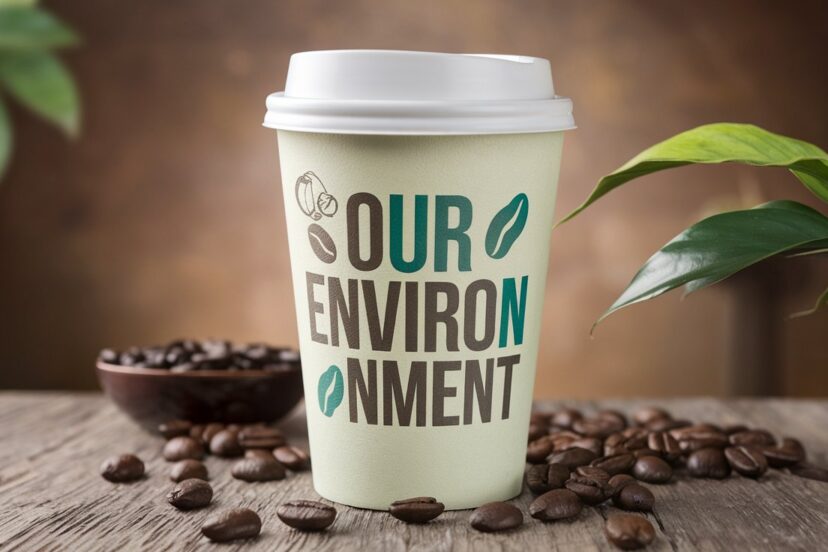Coffee’s Environmental Impact and Sustainability
*We may earn a commission for purchases made using our links. Please see our disclosure to learn more.
As a coffee enthusiast and environmental researcher, I’ve spent years exploring the relationship between our daily coffee and its environmental impact. Coffee, cherished by millions, goes beyond offering a comforting energy boost, it has significant consequences for the planet. From cultivation to processing, the coffee industry faces challenges in sustainability and waste management that are often overlooked by consumers.
In my travels across three continents, visiting coffee farms, processing facilities, and sustainable initiatives. I’ve seen both the environmental challenges and the creative solutions emerging within the industry. Small changes in farming practices, packaging, and waste management are helping reduce the environmental footprint of coffee production.
In this article, I’ll dive into coffee’s environmental impact, addressing issues like deforestation, water usage, and waste. I’ll also highlight the growing efforts to make coffee consumption more sustainable, with a focus on eco-friendly brands and waste reduction strategies. By adopting mindful choices, like choosing sustainable coffee options and reducing waste, we can make a positive impact on the environment.
The aim is to inspire you to enjoy your coffee with a greater awareness of its environmental impact. Supporting practices that contribute to a more sustainable future while still savoring the beloved cup of coffee each day.
Key Takeaways
- Coffee production generates substantial waste, but innovative solutions are emerging: Coffee’s environmental impact spans from cultivation to consumption, including water usage, deforestation, and waste from packaging. However, solutions like sustainable farming practices and eco-friendly packaging are helping to reduce these impacts.
- Circular economy principles in coffee can reduce waste by up to 80% through composting and upcycling: Embracing circular economy practices, such as composting coffee grounds and repurposing waste into useful products like fertilizers or biodegradable items, can cut waste by as much as 80%, transforming byproducts into valuable resources.
- Simple changes in consumer behavior can significantly impact sustainability: Small changes, like using reusable cups instead of disposable ones and properly recycling coffee packaging, can reduce waste. When adopted widely, these actions can have a big impact on sustainability.
- The coffee industry is increasingly adopting sustainable practices, from farm to cup: More coffee brands are prioritizing sustainability, from sourcing beans from environmentally conscious farms to reducing energy and water usage in production. Certifications like fair trade and organic farming are becoming more common, allowing consumers to make more eco-friendly choices.
- Technology and innovation are creating new opportunities for waste reduction: Advances in technology, from energy-efficient roasting techniques to waste-to-energy solutions, are helping the coffee industry reduce its environmental footprint. These innovations are opening up new ways to make coffee production more sustainable.
The Environmental Cost of Our Coffee Habit
When I first began researching coffee’s environmental impact, I was taken aback by the sheer scale of its influence. Each year, the global coffee industry generates over 23 million tons of waste, from agricultural residues to packaging materials. To put this into perspective, that’s the weight of more than 2,300 Eiffel Towers. The environmental footprint of coffee is much larger than many of us realize. Affecting every step of its journey, from farm to cup.
Coffee Production and Processing
The process starts on coffee farms, where traditional methods can use up to 40 liters of water just to produce one cup of coffee. When I visited coffee farms in Colombia and Ethiopia, I witnessed the immense water and energy consumption involved in growing and processing coffee. But it wasn’t all negative, there’s a growing movement among farmers to reduce waste and make use of byproducts in innovative ways.
For example, coffee pulp, which traditionally ends up in landfills or rivers, is being repurposed into organic fertilizers and biofuels. I spoke to farmers who’ve managed to reduce their reliance on chemical fertilizers by as much as 40%, thanks to the use of these natural alternatives. I also visited a cooperative in Guatemala where coffee pulp is transformed into nutrient-rich compost. Significantly lowering their environmental impact and eliminating the need for synthetic fertilizers. These practices are helping reduce both waste and the use of harmful chemicals. Contributing to a healthier planet and more sustainable coffee production.
Water use in coffee processing is another major environmental concern, especially in regions where water is already scarce. Traditional wet processing methods, which are preferred for producing high-quality coffee, can deplete local water supplies. However, I’ve seen promising new techniques emerging. In Kenya, I visited a processing facility that introduced a water recycling system, cutting its water consumption by 75% while maintaining the same high-quality coffee output. Innovations like these show that sustainability and quality don’t have to be at odds.
Distribution and Packaging
Once the coffee is processed and ready for sale, packaging becomes another significant environmental issue. Traditional coffee packaging often combines multiple materials, making it difficult or impossible to recycle. Single-serve coffee pods, in particular, have become a huge problem. With an estimated 59 billion pods produced annually, they could circle the Earth more than 36 times if lined up end to end. These pods are typically made from a combination of plastic and aluminum, which contaminates recycling streams and contributes to landfill waste. This is a clear example of coffee’s environmental impact.
However, the coffee industry is beginning to address this issue head-on. Some companies are creating biodegradable pods that decompose within 12 weeks in industrial composting facilities. I’ve worked with one such innovative startup that has developed fully compostable coffee pods, which are a step toward eliminating the waste caused by traditional pods. Additionally, major coffee chains are introducing reusable pod programs, where customers can return their used pods to be cleaned and refilled. These efforts are part of a larger trend within the coffee industry to reduce the amount of non-recyclable waste generated by packaging and improve sustainability.
Consumer Waste
One of the most alarming findings in my research was the sheer volume of waste generated by consumers. While many of us may be aware of the environmental impact of disposable coffee cups, the full extent of the problem is staggering. Every year, 16 billion disposable coffee cups are used worldwide, an amount equivalent to about 6.5 million trees worth of paper. The problem is further compounded by the fact that many of these cups are lined with plastic, making them difficult to recycle. As a result, most disposable cups end up in landfills, contributing to long-term environmental damage.
But it doesn’t stop there. Single-use coffee filters, plastic stirrers, and disposable lids also contribute to the growing waste problem. During a beach cleanup I participated in last year, coffee-related items, including cups, filters, and lids, made up nearly 20% of the collected waste. These small but widespread items are often overlooked, yet they add up to a significant environmental burden.
What’s particularly troubling is that much of this waste could be avoided with simple changes in consumer behavior. Using reusable coffee cups, for example, can reduce the need for disposable cups. Some coffee shops even offer discounts for customers who bring their own cups, encouraging more sustainable habits. Additionally, reusable filters, compostable cups, and other eco-friendly alternatives are becoming more widely available. If more people make the switch to these sustainable options, the environmental impact of coffee consumption could be drastically reduced.
The Bigger Picture
The environmental cost of our coffee habit may seem overwhelming, but it’s important to remember that we all play a part in both the problem and the solution. Coffee’s environmental impact is significant, but the coffee industry is evolving, with farmers, companies, and consumers all taking steps to address the challenges it faces. From implementing sustainable farming practices to reducing waste in packaging and encouraging eco-friendly consumer behavior, there are countless ways to reduce the environmental impact of coffee.
The growing awareness of these issues means that change is happening, but it’s up to each of us to make conscious choices in our own coffee habits. Whether it’s choosing sustainably sourced coffee, supporting companies that prioritize eco-friendly packaging, or reducing our personal waste, every action counts. As we continue to enjoy our daily cups, we have the power to help create a more sustainable and environmentally responsible coffee culture.
Solutions and Innovations

The coffee industry is actively working to address these sustainability challenges, and I’ve witnessed remarkable innovations in recent years. From farm-level solutions to consumer-focused initiatives, the sector is embracing sustainability like never before.
Sustainable Production Methods
Forward-thinking coffee farms are implementing water-efficient processing methods and closed-loop systems. By using advanced water filtration and recycling systems, some processors have reduced water consumption by up to 80%. These methods not only conserve resources but also protect local water sources from contamination.
During my visit to a coffee cooperative in Costa Rica, I saw how they’ve implemented a novel processing method that uses the natural mucilage of the coffee cherry to facilitate fermentation, significantly reducing water usage. This “honey process” not only conserves water but also creates unique flavor profiles that consumers appreciate.
Packaging Revolution
The packaging sector is undergoing a transformation. Biodegradable materials, recycled content, and innovative designs are becoming more common. I’ve tested several new packaging solutions that maintain coffee freshness while being fully compostable, a significant breakthrough for the industry.
One particularly promising development is the use of agricultural waste in packaging materials. A company in Vietnam is using coffee chaff, the skin of the bean that comes off during roasting – to create biodegradable packaging materials. This approach not only reduces waste but also creates a closed-loop system within the coffee industry.
Consumer Solutions
As consumers, we have numerous options to reduce our coffee-related waste. Through my own experience and research, I’ve identified several effective strategies:
- Use reusable cups and filters
- Choose bulk coffee over single-serve options
- Composting coffee grounds
- Supporting brands with sustainable packaging
- Properly recycling coffee packaging materials
I’ve found that implementing these changes in my own life has reduced my coffee-related waste by over 90%. More importantly, these changes haven’t diminished my enjoyment of coffee – if anything, they’ve enhanced it by adding a layer of environmental consciousness to my daily ritual.
The Future of Sustainable Coffee
Looking ahead, I see tremendous potential for further improvements in coffee sustainability. Technology is enabling better tracking of coffee’s environmental impact, while research continues to uncover new uses for coffee waste. From mushroom cultivation using spent grounds to creating fabric from coffee cherry waste, innovation is transforming the industry’s approach to sustainability.
Blockchain technology is being implemented to track coffee from farm to cup, ensuring transparency in sustainable practices. I recently participated in a pilot program where consumers could scan a QR code on their coffee package to see the entire journey of their beans, including water usage and waste management practices at each step.
Emerging Technologies
The future of sustainable coffee is being shaped by cutting-edge technologies. Artificial intelligence is being used to optimize irrigation systems and predict optimal harvesting times, reducing resource waste. Some roasters are using solar power and electric roasting equipment to reduce their carbon footprint.
One particularly exciting development I’ve been following is the use of bioactive compounds from coffee waste in the cosmetics and pharmaceutical industries. This could create new value streams for coffee farmers while reducing waste.
Conclusion
The coffee industry’s relationship with sustainability is complex but improving. Through my research and personal experience, I’ve seen that meaningful change is possible when producers, companies, and consumers work together. Coffee’s environmental impact remains a challenge, but the growing awareness and implementation of sustainable practices give me hope for a more environmentally friendly coffee industry.
The key to success lies in continued innovation, consumer education, and industry collaboration. As someone deeply invested in both coffee and environmental sustainability, I’m optimistic about the future. Every cup of coffee represents an opportunity to make a positive environmental impact, and collectively, these small changes can lead to significant improvements in sustainability.
Frequently Asked Questions
Q: What can I do with used coffee grounds?
A: Coffee grounds can be composted, used as natural fertilizer, added to garden soil as pest control, or even used in beauty treatments. Some innovative companies are now using them to grow mushrooms or create biofuel. In my own garden, coffee grounds have proven particularly effective for acid-loving plants like blueberries and azaleas.
Q: Are coffee pods always bad for the environment?
A: While traditional coffee pods can be environmentally problematic, new recyclable and biodegradable options are available. If you prefer pod systems, look for these sustainable alternatives or consider using refillable pods. Some manufacturers now offer pod recycling programs where you can return used pods for proper processing.
Q: How much water does coffee production really use?
A: Traditional coffee processing can use up to 40 liters of water per cup of coffee produced. However, new processing methods and water recycling systems can reduce this consumption by up to 80%. Some innovative farms are now implementing dry processing methods that require minimal water usage.
Q: Does organic coffee mean it’s more sustainable?
A: Organic certification ensures certain environmental standards in cultivation, but sustainability encompasses more factors, including water usage, packaging, and transportation. Look for certifications that address multiple aspects of sustainability, and consider the entire supply chain when making purchasing decisions.
Q: How can I identify sustainably produced coffee?
A: Look for certifications like Rainforest Alliance, Bird Friendly, or Fair Trade. Also, research brands that prioritize transparency in their supply chain and environmental practices. Many roasters now provide detailed information about their sustainability initiatives and are happy to answer specific questions about their environmental practices.




